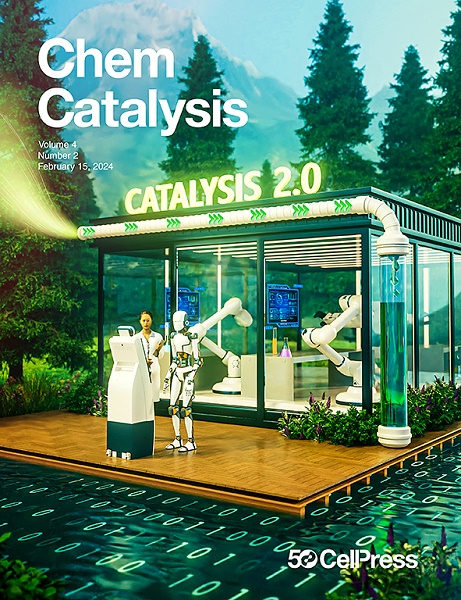Effect of dilute Rh on oxygen dissociation, spillover, and the oxidation of Cu across many orders of magnitude pressure
IF 11.6
Q1 CHEMISTRY, PHYSICAL
引用次数: 0
Abstract
Knowledge of how trace amounts of more reactive metals influence the oxidation rate and mechanism of Cu surfaces is essential for developing strategies to optimize the performance of Cu-based catalysts. We find that the addition of 1% Rh to Cu(111) increases the initial O2 dissociation rate by approximately 9-fold. CO poisoning experiments reveal that single Rh atoms activate O2 and facilitate the spillover of atomic oxygen to Cu sites. Scanning tunneling microscopy (STM) and in situ X-ray photoelectron spectroscopy (XPS) support this mechanism, showing enhanced surface oxygen near Rh atoms. A density functional theory (DFT)-based model demonstrates that Rh binds the O2 precursor 0.15 eV more strongly than Cu(111) and lowers the O2 dissociation barrier by 0.02 eV. Both single-crystal and nanoparticle experiments show that at low oxygen pressures, Rh enhances Cu oxidation, whereas at higher pressures, it inhibits deeper oxidation, as evidenced by in situ ultraviolet-visible (UV-vis) spectra.

在多个数量级压力下,稀Rh对氧解离、溢出和Cu氧化的影响
了解微量活性金属如何影响Cu表面的氧化速率和机理,对于制定优化Cu基催化剂性能的策略至关重要。我们发现,在Cu(111)中加入1%的Rh可使初始O2解离率提高约9倍。CO中毒实验表明,单个Rh原子激活O2,促进原子氧向Cu位点溢出。扫描隧道显微镜(STM)和原位x射线光电子能谱(XPS)支持这一机制,显示Rh原子附近的表面氧增强。基于密度泛函理论(DFT)的模型表明,Rh对O2前体的结合比Cu(111)强0.15 eV,并使O2解离势垒降低0.02 eV。单晶和纳米粒子实验表明,在低氧压力下,Rh促进Cu的氧化,而在高氧压力下,它抑制更深层次的氧化,这一点得到了原位紫外可见(UV-vis)光谱的证明。
本文章由计算机程序翻译,如有差异,请以英文原文为准。
求助全文
约1分钟内获得全文
求助全文
来源期刊
CiteScore
10.50
自引率
6.40%
发文量
0
期刊介绍:
Chem Catalysis is a monthly journal that publishes innovative research on fundamental and applied catalysis, providing a platform for researchers across chemistry, chemical engineering, and related fields. It serves as a premier resource for scientists and engineers in academia and industry, covering heterogeneous, homogeneous, and biocatalysis. Emphasizing transformative methods and technologies, the journal aims to advance understanding, introduce novel catalysts, and connect fundamental insights to real-world applications for societal benefit.

 求助内容:
求助内容: 应助结果提醒方式:
应助结果提醒方式:


